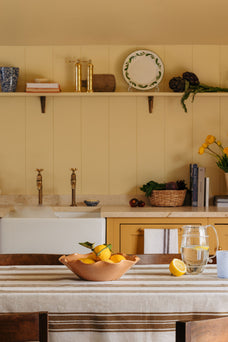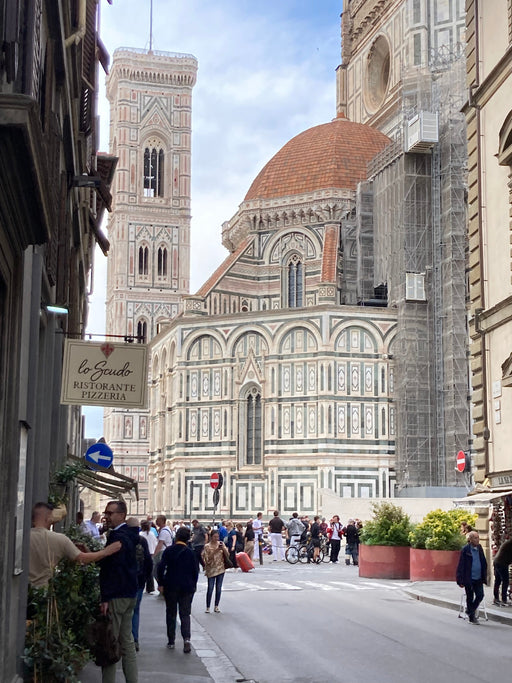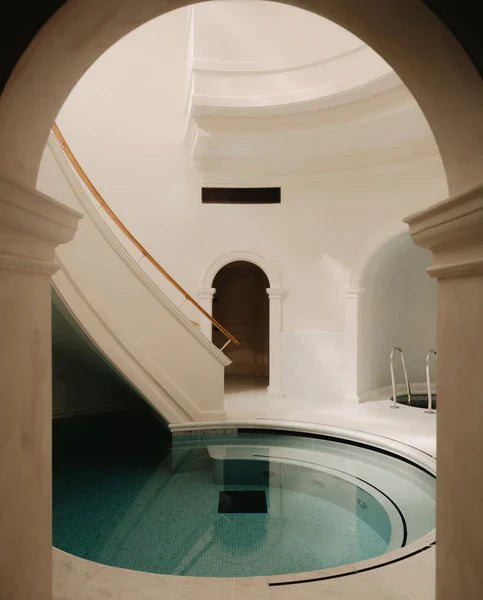The city of love, water, canals, bridges and masks – Venice has many guises, alongside being one of Italy’s most visited destinations. To celebrate the launch of our new Murano glassware, handcrafted by Venetian artisans, we are launching our new travel guide series with a focus on a city that is one of Rebecca's favourites.
To accompany Rebecca’s advice for first-time visitors to Venice and her favourite place to stay in the city, we welcome Martina Casonato of The Venetian Pantry. Designer, photographer and podcaster, Martina grew up in a small town in the Venetian countryside, making her perfectly positioned to share the insider secrets of her home city.

Rebecca’s Advice for First Time Visitors to Venice
A must is to book a water taxi from the airport into the city – private, if you can. It really is a mesmerising introduction to Venice that’s worth every penny.
Visiting Murano island is an essential part of any trip to Venice. I haven’t participated in a glass tour as I am on the island to visit our manufacturers, but if you are in Venice on holiday, I think this would be really worth doing. I haven’t had a chance to do Burano yet - I never quite have enough time! - but it is on the list for next time and have heard great things.
I would also recommend going off-season, although be mindful that certain shops are closed during January and February. I think anytime in March, April or October would be a lovely time to go. I, personally, couldn’t imagine visiting in the height of summer as the paths are so small, I like to walk quickly and I don’t enjoy crowds!
I think two - three nights would be optimum for visiting Venice. If I were visiting for leisure, I would tie it in with visiting one of the Italian lakes. It is very easy to reach Lake Garda on a direct train (1.5 hour journey) or you can take a train to Milan and catch a train to Lake Como (3.5 hours overall).

Rebecca’s Favourite Venetian Hotel
I can recommend Il Palazzo Experimental to anyone visiting Venice. It is conveniently central, design-forward and situated right on the water with plenty of natural light. The Dorsoduro district has many beautiful canals and quaint bridges, and feels dreamlike to wander around.
I certainly think you could stay somewhere slightly inland or on a neighbouring island if you’re not keen on compact living - there are some especially luxurious hotels on some neighbouring islands. Living in the countryside and being used to a certain way of living, I like to be able to see the sky from my hotel room. While I find Venice to be very cosy, staying in the centre of the city could feel enclosed to some; the paths are narrow and light can be limited. It is a majestic city however and I would imagine you will feel that wherever you choose to rest your head.
Martina’s Recommendations for Where to Eat in Venice
Bacari
Venice can be a tricky city to navigate when it comes to food, as tourist traps are unfortunately quite common. My favourite way to eat through the city is by visiting Bàcari – small bars selling Cicchetti, the quintessential Venetian snack that you eat standing up. Cicchetti are similar to Crostini – thin slices of bread topped with a variety of heavenly ingredients (my go-to is Sarde in Saor). There are plenty of Bacàri in town, but some of my favourites are Bar all’Arco, Arcicchetti Bakaro, Bacaro Risorto and Al Timon.

Osterie
If you’d rather enjoy a sit down meal, there are still a few places that haven’t been taken over by the tourist machine. Osterie are typical Venetian restaurants with a familiar, informal vibe. One such treasure is Osteria Ca’ D’oro Alla Vedova, famed for their polpette (and, at least to me, their beautiful embroidered napkin-covered lampshades). For a vegetarian-friendly menu, head to La Zucca. Or, if you are after good fish and a romantic dinner, I’d recommend Osteria Ai Artisti, just off the Accademia Bridge.
Fine Dining
On the island of Mazzorbo, next to the more well-known island of Burano (famed for traditional lace artisans), you’ll find Venissa, a one-starred Michelin restaurant headed by chef Chiara Pavan. To have a meal there is an experience in itself, as is trying a sip of their home-grown rare wine, cultivated a few metres away in the only vineyard in Venice. Aside from their glorious km0 menu, Venissa also offers a slightly more casual dining setting with their Osteria, as well as beautiful rooms and experiences.

Martina’s Favourite Places to Shop in Venice
Aside from perusing the streets of Murano collecting beautiful hand-laced handkerchiefs and embroidered bedding (which sadly is a dying art), one shop I always like to visit in Venice is Il Papiro, a stationary paradise if handmade marbled paper is your thing.
Another Venetian artisan product that is perhaps less known abroad are the classic Friulanes. Think of them as chic slippers people wear outdoors, combining comfort and elegance. The place to go to grab an authentic, artisanal pair is Piedàterre, near S.Polo. It has been operating since 1952.
Finally, for the foodies amongst us, no trip to Venice is complete without taking home as souvenirs some Essi, Bussolai or Zaetti – all types of traditional Venetian cookies. There are many historic bakeries where you can purchase them: I’d recommend Pasticceria Rosa Salva in Rialto, Pasticceria Tonolo and Pasticceria Rizzardini (the most historic in Venice, operating since 1742) in S.Polo, Carmelina in Burano, and Pasticceria Dal Mas in Cannaregio.


Martina’s Local Tips for Visiting Venice
If you quite fancy a trip on a gondola, but not the eye-watering fare of the ride, fear not – you can still have a little taste of the experience at a very reasonable price. Gondola Traghetto di Santa Sofia allows you to cross the Canal Grande aboard a Gondola for only a couple of euros.
If you want to beat the crowds and explore quieter areas of the city, head to the historic jewish quarters of Cannaregio, or student-centric Dorsoduro (you’ll find very affordable Bacari here!). Campo Santa Margherita in Dorsoduro is a lovely square where you can observe authentic Venetian local life.
Whilst in Cannaregio, head to Teatro Italia, a former Neo-gothic theatre converted to a mass-market supermarket. The juxtaposition between the neon aisle lights filled with commercial products and beautiful historical affrescos is rather jarring, and the choice of usage of this space has definitely sparked controversy. Regardless of what your thoughts will be (whether you think it a heresy or the ultimate elevation of the mundane), it’s definitely something unusual to experience.

Contributor: Martina Casonato of The Venetian Pantry
Martina likes to have her fingers in many pies: a graphic designer, photographer, interior designer, recipe creator and, most recently, podcaster, Martina grew up in a small town in the Venetian countryside, but has been living in North-East London for well over a decade now.
On her Instagram account @thevenetianpantry, she shares her passion for all things home, food & travel. On Substack, she writes about the uncanny aspects of the Italian way of life she misses, as well as sharing her travel and home renovation tips. Her new podcast, Spilling Tea, was born out of a desire to share inspiring conversations with interesting people she has met through The Venetian Pantry, with a focus on entrepreneurship and, in particular, female entrepreneurship.
All images by Martina Casonato.
|products|
Discover our Murano glassware collection, hand crafted by heritage artisans on Murano island in Venice.

















